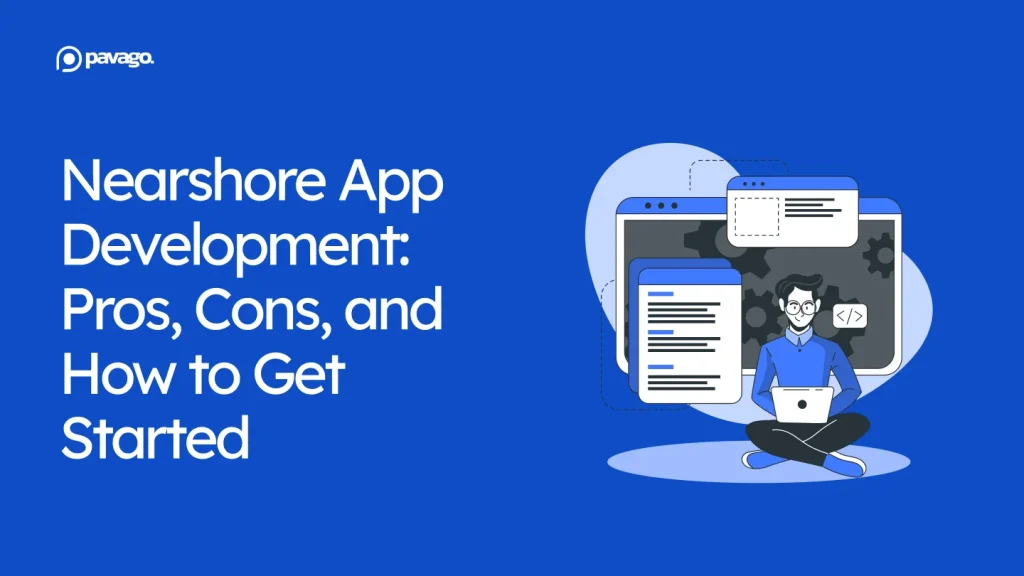If you’ve ever tried building an app with a team halfway across the world, you already know the pain.
The delays.
The late-night messages.
The cultural gaps that turn small misunderstandings into big slowdowns.
On the other hand, hiring locally sounds ideal… until you see the cost.
That’s why more companies are turning to nearshore application development, a model that gives you access to top-tier talent in nearby regions, with shared time zones, faster collaboration, and cost savings that don’t come at the expense of quality.
Let’s break down why nearshore development is becoming the smart, scalable choice for modern businesses – and why now is the best time to make the move.
Want a shortcut to hiring A-player nearshore app developers? Pavago can help.
You get A-players embedded in your team, working your hours, without agency markups or hiring risk.
What “Nearshore” Really Means
Nearshore development simply means outsourcing your application development to professionals in nearby regions or similar time zones.
For U.S. companies, that often means Latin America – countries like Mexico, Colombia, Brazil, or Argentina. For Europe, it might be Eastern Europe or North Africa.
The key difference from “offshore” is proximity. You’re not dealing with a 10-hour time gap, delayed feedback, or overnight handoffs that break project flow. You’re working with full-stack developers who are close enough to collaborate in real time, but far enough to save you serious money.
For growing companies that need speed, cost-efficiency, and quality at the same time, that balance is everything.

Why Companies Are Moving to Nearshore Teams
Few years ago, most companies looking to cut costs chose offshore dedicated teams. But as projects got more complex and collaboration became the bottleneck, nearshore development emerged as the smarter option.
Here’s what’s driving the shift, and why the smartest teams are already there:
1. Lower Costs Without Sacrificing Quality
Nearshoring doesn’t mean you’re hiring “cheap talent.” You’re just hiring A-players in different economies with significantly lower cost of living. That means you can cut your development costs by 50% while maintaining top-tier quality.
It’s not cost-cutting – it’s cost optimization.
2. Real-Time Collaboration & Faster Turnaround
Working with teams in similar time zones means fewer delays, easier communication, and faster development cycles. Unlike offshore teams that work while you sleep, nearshore teams can collaborate with you in real time.
3. Stronger Cultural & Business Alignment
Nearshore developers often share similar work ethics, communication styles, and business expectations as companies in the U.S. or Europe. This makes collaboration smoother and reduces misunderstandings compared to offshore teams.
4. Access to Specialized Talent
Regions like LATAM and Eastern Europe are filled with world-class engineers who’ve worked with global startups and Fortune 500s alike.
You can tap into advanced skills, including AI developers, DevOps engineers, and more, without competing for overpriced local hires.
5. Better IP & Data Security Compliance
Compared to offshore teams in far-reaching regions, nearshore developers are often subject to stricter legal and data protection regulations that align with U.S. or European standards, reducing compliance risks.
The Real Advantages Over Offshore
Offshore development still has its place, but nearshore fixes many of its biggest flaws:
| Challenge (Offshore) | Solution (Nearshore) |
|---|---|
| Time zone mismatch | Overlapping work hours |
| Communication delays | Real-time collaboration |
| Cultural differences | Shared business norms |
| Long delivery cycles | Faster iteration |
| Quality inconsistencies | Easier management and accountability |
The Common Objections (and Why They Don’t Hold Up)
While nearshore application development solves many offshore outsourcing challenges, there are certain objections. However, they don’t really hold up.
“But nearshore is more expensive than offshore.”
True, but that’s like saying a Tesla costs more than a Hyundai. You get what you pay for. Nearshore delivers greater ROI in efficiency, speed, and quality.
“I’ve tried outsourcing before, but it didn’t work.”
You probably picked the wrong model. Nearshore fixes what offshore outsourcing might get wrong: poor communication and lack of ownership.
“I’m worried about control.”
When you hire through the right partner (like Pavago), your developers report directly to you – not a middleman agency. You manage priorities, we handle the backend.
How AI Is Making Nearshore Teams Even Stronger
AI isn’t replacing developers – it’s amplifying them. And nearshore developers who know how to use AI tools are delivering faster, cleaner, and smarter work than ever before.
Here’s how AI is transforming nearshore application development:
- AI-assisted coding: Faster development and cleaner codebases.
- Automated testing: Bugs caught early, fewer regressions.
- Predictive analytics: Better sprint planning and resource allocation.
- AI-driven DevOps: Reduced deployment time and smarter automation.
At Pavago, we specifically vet developers who know how to leverage AI tools to multiply efficiency and deliver cleaner, faster, and more reliable code.
The Verdict: Is Nearshore Application Development Worth It?
If you want real-time collaboration, strong communication, and lower costs without the chaos of offshore outsourcing, nearshore development is the smart move.
You get skilled developers in your time zone who understand your culture, work your hours, and deliver faster – at a fraction of local hiring costs.
It’s not the cheapest option, but the trade-off is worth it: better communication, smoother workflows, and stronger accountability.
If cutting costs is your only goal, offshore can still work. But if you care about speed, quality, and a team that feels like part of your company, nearshore is the better choice.
And that’s where Pavago comes in.
How To Get Start with Nearshore Application Development
Most agencies add layers between you and the talent.
Freelancers are hit or miss.
Pavago is different.
Pavago helps you hire A-players directly – full-time nearshore developers who integrate into your business like employees, not third-party agents.
You get:
- Top 1% vetted engineers with proven technical and communication skills.
- One flat monthly rate – no hidden markups, ever.
- Lifetime replacement guarantee, so your seat never goes empty.
- Payroll, HR, and contracts handled, so you can focus on shipping product.
In short, we make nearshore hiring as simple, reliable, and scalable as it should be.

FAQs About Nearshore Application Development
1. How much does nearshore app development cost compared to onshore and offshore?
Nearshore application development typically costs 30-50% less than onshore hiring but is still more expensive than offshore outsourcing.
For example, a U.S.-based developer may charge $100-$150 per hour, while a nearshore developer in Mexico or Colombia might charge $40-$80 per hour – offering significant savings while maintaining high-quality standards.
2. What’s the difference between nearshore and offshore development?
The biggest differences between nearshore and offshore are time zone alignment, communication efficiency, and project speed.
Nearshore teams work in similar time zones, making collaboration easier and reducing delays. Offshore teams, while cheaper, often require late-night meetings and slower response times due to the time gap.
3. Are there any risks with nearshore hiring?
The main risks include varying labor laws, legal contracts, and pricing differences between nearshore regions. However, these risks are far lower than offshore outsourcing since nearshore teams often follow U.S. and European business standards.
Choosing a reliable hiring partner helps navigate these challenges.
4. How do I find and hire the right nearshore mobile app development team?
Start by defining your project requirements, then look for trusted nearshore outsourcing companies, staffing platforms, or direct-hire professionals with experience in your industry.
Vet candidates through portfolio reviews, test projects, and clear communication expectations.
Wrapping It Up
Nearshore application development isn’t just another outsourcing trend; it’s how smart companies are scaling in a world where collaboration and cost both matter.
You don’t need to pick between affordability and quality anymore.
You can have both — if you go nearshore, and if you build your team the right way.
At Pavago, we’ve helped dozens of growing businesses bridge that gap, giving them A-players at fair prices, working in sync, and driving real results.
Build your nearshore team with Pavago today. Hire elite developers who work your hours, share your standards, and deliver results
















